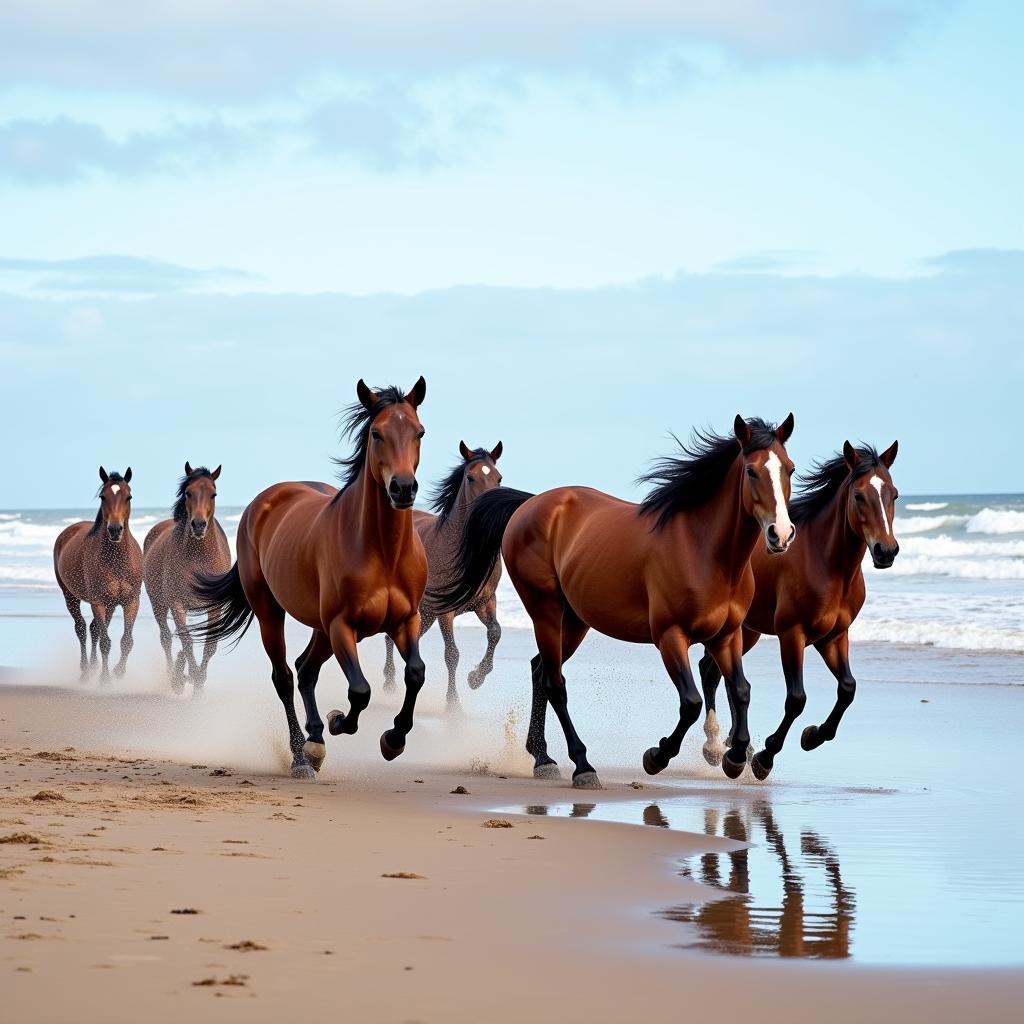Sable Island’s wild horses are a breathtaking sight, captured beautifully in countless photographs and videos. This Wild Horses Of Sable Island Gallery will delve into the fascinating world of these majestic creatures, exploring their history, behavior, and the unique environment they call home. We’ll also touch upon the importance of conservation efforts and how you can appreciate these animals responsibly.
The Untamed Beauty of Sable Island’s Wild Horses
Sable Island, a remote crescent-shaped sandbar off the coast of Nova Scotia, Canada, is home to a population of approximately 500 feral horses. These horses, descendants of animals introduced to the island in the 18th century, have adapted to the harsh, windswept environment, developing a unique hardiness and captivating wild spirit. Their shaggy coats and flowing manes, often sculpted by the constant winds, add to their rugged charm.
These horses live in small bands, typically consisting of a dominant stallion, several mares, and their foals. The social dynamics within these bands are complex and constantly evolving, offering a glimpse into the natural behavior of horses free from human intervention. They graze on the island’s sparse vegetation, primarily marram grass and beach pea, and drink from the freshwater ponds scattered across the landscape.
A History Woven in Sand and Salt Spray
The history of Sable Island’s horses is as intriguing as the island itself. While the exact origins remain debated, it’s widely believed that the current population descends from horses confiscated from Acadians during the Great Upheaval in the 18th century. Left to fend for themselves, these horses adapted remarkably to the challenging environment. Over the centuries, other horses, including shipwrecked workhorses and riding horses, may have contributed to the gene pool.
For centuries, these horses roamed free, facing the elements and shaping their own destiny. They became a symbol of resilience and freedom, their story intertwined with the island’s maritime history and the legends of shipwrecks and survival.
Preserving a Legacy: Conservation Efforts for Sable Island’s Horses
Recognizing the ecological and cultural significance of these horses, Sable Island became a National Park Reserve in 2013. This designation aims to protect the island’s unique ecosystem, including its wild horse population. The horses are not managed, allowing them to live as naturally as possible. Researchers closely monitor the population, studying their behavior, social dynamics, and adaptation to the ever-shifting sands.
 Sable Island Horses Running on the Beach
Sable Island Horses Running on the Beach
Experiencing the Magic: Responsible Wildlife Viewing
While visiting Sable Island can be a truly remarkable experience, it’s crucial to prioritize responsible wildlife viewing. Access to the island is strictly regulated to minimize human impact on the delicate ecosystem and the horses’ natural behavior. Visitors must obtain permits and adhere to strict guidelines, including maintaining a safe distance from the horses and refraining from any interaction that could disrupt their routine.
“Respecting their space is paramount,” says Dr. Sarah Jones, a wildlife biologist specializing in equine behavior. “These horses are wild and deserve to live undisturbed. Observing them from a distance allows us to appreciate their natural beauty and behavior without interfering with their lives.”
What are the key threats to the Sable Island horses?
The primary threats are environmental changes, such as coastal erosion and extreme weather events.
A Gallery of Resilience: The Future of Sable Island’s Wild Horses
The wild horses of Sable Island stand as a testament to the power of adaptation and the enduring spirit of wildness. Protecting their future requires continued conservation efforts, responsible tourism, and ongoing research. Through these combined efforts, we can ensure that these magnificent creatures continue to roam free on their windswept island sanctuary for generations to come.
“These horses represent a unique piece of natural history,” adds Dr. Jones. “Their story is a powerful reminder of the importance of preserving wild spaces and the creatures that call them home.” By understanding and respecting these animals, we can contribute to their long-term survival and continue to be captivated by their untamed beauty.
Conclusion
The wild horses of Sable Island offer a captivating glimpse into a world untouched by human domestication. This wild horses of sable island gallery highlights the importance of their preservation and the need for responsible interaction. By understanding their history, appreciating their beauty, and supporting conservation efforts, we can ensure that these majestic creatures continue to thrive on their unique island home.
FAQ
- How many wild horses are on Sable Island? Approximately 500.
- Can I visit Sable Island to see the horses? Yes, but access is restricted and requires permits.
- What do the horses eat? Primarily marram grass and beach pea.
- Are the horses managed? No, they live wild and are not managed by humans.
- Why is Sable Island a National Park Reserve? To protect its unique ecosystem, including the wild horses.
- What are the biggest threats to the horses? Environmental changes and human interference.
- How can I support the conservation of Sable Island horses? By respecting their environment, following visitation guidelines, and supporting conservation organizations.
Need support? Contact us: Phone: 0772127271, Email: [email protected] or visit us at QGM2+WX2, Vị Trung, Vị Thuỷ, Hậu Giang, Vietnam. We have a 24/7 customer service team.